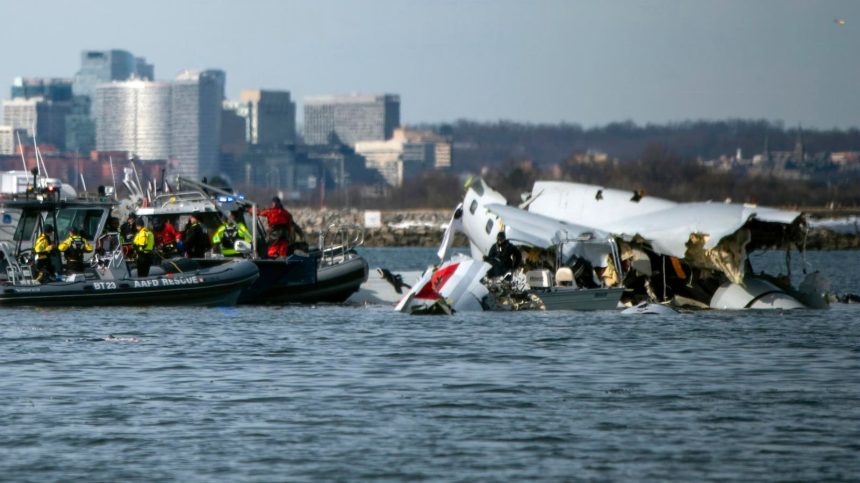The Collision and Initial Response:
On the evening of January 29th, a Bombardier CRJ700 regional jet, operated by PSA Airlines for American Airlines, collided with a U.S. Army Black Hawk helicopter near Reagan National Airport in Washington, D.C. The jet, en route from Wichita, Kansas, was carrying 60 passengers and four crew members, while the helicopter had three personnel on board. The collision occurred shortly before 9 p.m. local time as the plane was approaching the runway for landing. Emergency responders arrived at the scene within minutes, encountering challenging conditions due to rough waters and strong winds in the Potomac River where the wreckage came down. Initial rescue operations quickly transitioned to recovery efforts as authorities determined there were likely no survivors. The airport was immediately shut down following the crash, disrupting air traffic in the region. Former President Trump, on his Truth Social platform, questioned the actions of the helicopter pilot and air traffic controllers, speculating about why the collision wasn’t avoided. The White House confirmed that Trump had been briefed on the incident and that federal and local authorities were working to address the situation.
Investigation and Recovery Efforts:
The National Transportation Safety Board (NTSB) launched an investigation into the crash, recovering the plane’s cockpit voice recorder and flight data recorder—commonly known as "black boxes"—within 24 hours. These devices contain crucial information about the flight’s final moments and are instrumental in determining the cause of the accident. Recovery divers worked diligently to retrieve bodies and wreckage from the Potomac River, despite adverse weather conditions. By Friday afternoon, over 40 bodies had been recovered, including those of the helicopter’s crew. Identifying the victims and notifying their next of kin became a priority for authorities. The NTSB, working with local officials, aimed to release a passenger manifest to aid in this process. Early reports indicated potential staffing issues at the air traffic control tower, with suggestions that a single controller was handling both helicopter and airplane traffic, a task typically assigned to two individuals. However, conflicting accounts emerged about whether the staffing levels were normal or if a supervisor had combined the roles prematurely.
Controversy and Speculation:
The tragedy unfolded amidst a backdrop of political controversy. Former President Trump, in various statements, placed blame on several factors, including air traffic controllers, the helicopter pilots, and diversity, equity, and inclusion (DEI) hiring practices within the FAA implemented during the Obama and Biden administrations. He suggested, without evidence, that DEI initiatives had led to the hiring of less qualified air traffic controllers. These claims were swiftly rebuked by former transportation officials and the National Air Traffic Controllers Association, who emphasized that air traffic controller hiring is based on rigorous testing and qualifications, not on race or gender. They also highlighted that air traffic control towers nationwide often operate understaffed, potentially contributing to increased workload and stress for controllers.
Victims and Their Stories:
As details emerged about the passengers on board the downed aircraft, the human toll of the tragedy became increasingly apparent. The U.S. Figure Skating community was particularly affected, with fourteen members of the team, along with coaches and parents, among the victims. They were returning from a training camp in Wichita, Kansas, following the U.S. Championships. Among the deceased were renowned skating coaches Evgenia Shishkova and Vadim Naumov, former world champion pairs skaters. Other victims included young aspiring skaters, lawyers, and a group of friends returning from a hunting trip. Two Chinese nationals and a police official from the Philippines were also identified among the casualties.
Focusing on Safety and Accountability:
The investigation into the crash continues, with the NTSB meticulously analyzing the recovered black boxes and other evidence. Determining the precise sequence of events leading to the collision will be crucial for preventing similar incidents in the future. While political figures engaged in speculation and blame-shifting, the focus remained on understanding the factors that contributed to the tragedy and ensuring accountability. The incident served as a stark reminder of the complex and demanding nature of air traffic control and the importance of maintaining adequate staffing levels and rigorous safety protocols in this critical field.
Analyzing the Timeline and Key Information:
The timeline of events reveals a rapid unfolding of the tragedy, from the initial collision to the immediate response and the subsequent investigation. The recovery of the black boxes from both aircraft provides a vital source of data for understanding the events leading to the crash. The identification of the victims and the notification of their families is a somber but necessary process. The controversy surrounding staffing levels at the air traffic control tower raises questions about potential systemic issues that may have contributed to the accident. The political debate surrounding DEI hiring practices, while contentious, underscores the importance of ensuring a qualified and competent workforce in critical safety roles. The stories of the victims, particularly those from the U.S. Figure Skating community, highlight the human cost of the tragedy and the far-reaching impact of such events. The ongoing investigation by the NTSB will be essential for determining the precise cause of the crash and for implementing measures to prevent future occurrences. This tragedy serves as a reminder of the importance of vigilance and continuous improvement in aviation safety.



